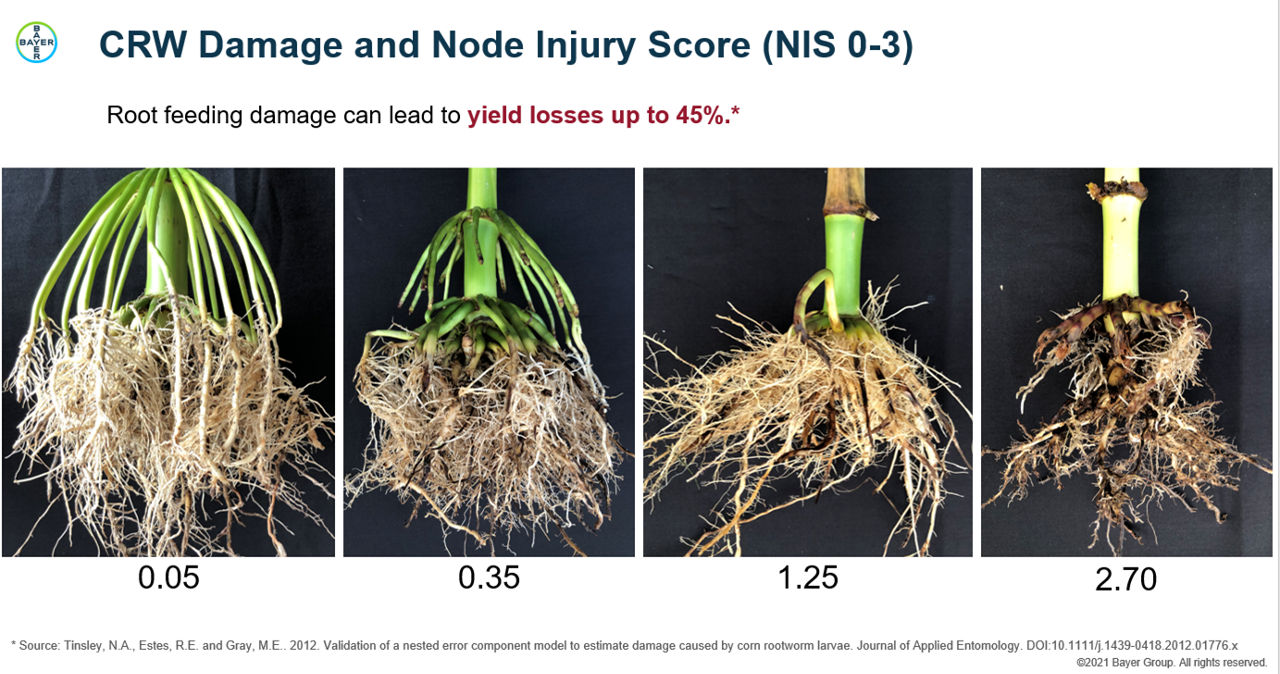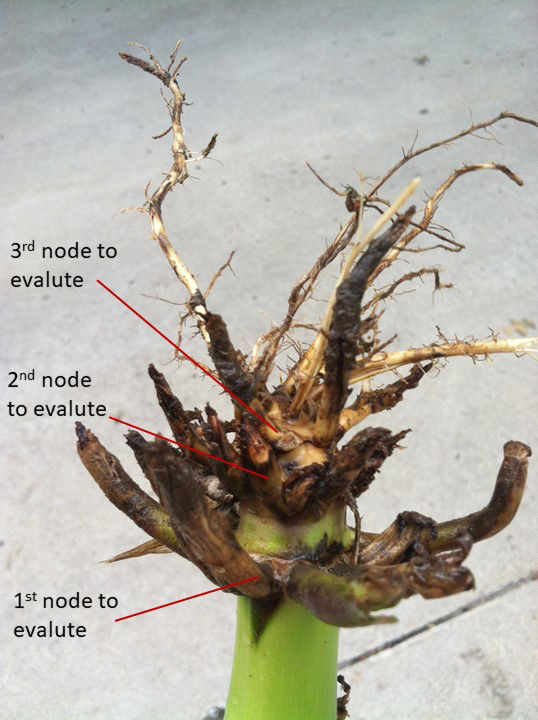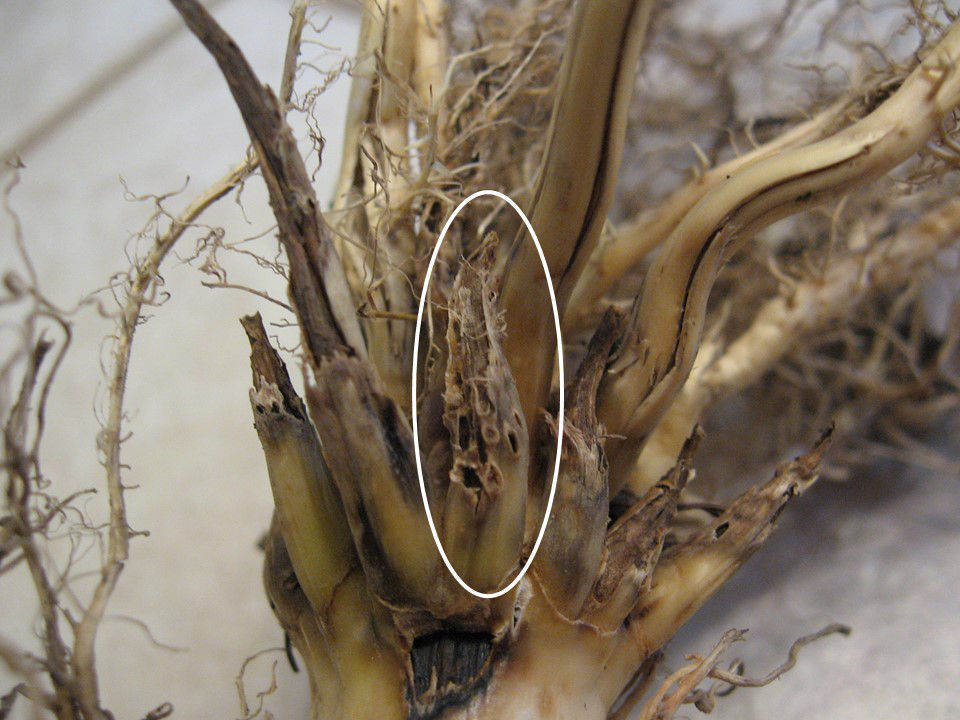7 MIN READ
Conducting Root Digs for Corn Rootworm
November 2, 2023
Introduction
Root digs are an important part of managing corn rootworm (CRW) because they help farmers evaluate CRW injury and assess the effectiveness of different control measures. Root digs should take place at the optimum time and damage should be evaluated using the Iowa State University 0 to 3 node-injury scale (NIS 0 to 3).
Timing of Root Digging
Root damage from CRW is highest when the majority of larvae have completed the third larval stage, which is often around the tasseling stage of corn in July or August. The third larval stage can occur as early as June if above-average temperatures occur in spring and early summer. Ideally, there is a 2- to 3-week window when timing is optimal for digging roots. Digging roots too early before larvae have completed development can underestimate the potential total damage. Additionally, roots dug after most adults have emerged are often more difficult to wash and rate due to root regrowth.
Tactics to Effectively Use Root Digging
- Five consecutive corn plants should be dug in at least three random locations throughout the field. If evaluating the efficacy of different CRW treatments, dig several plants per treatment.
- Digging plants from an area with no biotech trait to control CRW and/or no soil insecticide can help determine the overall CRW pressure, but ensure the plants are dug from the same field—or at least from fields managed similarly—as the traited and/or insecticide-treated corn plants that are also dug.
- If the CRW larvae pressure is light in this ‘untreated’ area, it is likely that feeding differences will be minimal in treated areas of the field and further digging may not be warranted.
- Removing the upper portion of the plant about 1-2 feet (30 to 60 cm) above the root mass can help make handling (hauling out of the field, washing, etc.) much easier. Consider using 4-inch (10 cm) masking tape to tape the stalks together, as doing so makes removing the plants from the field easier and provides a place to appropriately label the plants with a permanent marker.
- Dig the root mass about 6 or 7 inches (15 to 18 cm) from the stalk to ensure the dug root mass is large enough to examine and the shovel has done minimal injury to the roots. Knocking some of the soil off can help reduce the size of the root mass, but care should be taken to not break the roots off.
Washing
Washing roots immediately after digging may remove some of the smaller roots with the soil; therefore, roots should be soaked in a tub of water for 30 minutes or more to help loosen soil from the roots before washing. If CRW larvae or pupae are present in the root ball, they may float to the top of the water while the roots are soaking. In some cases, particularly with heavy clay soil, a deflocculating agent such as Calgon® can be used.
Roots should be washed carefully using a pressure washer or strong hose. To avoid unwanted injury to the roots, the pressure washer should be on a low setting. After washing, the roots are ready to be rated.
Root Rating
When rating roots, carefully pull the roots back at each node to allow for easier inspection of rootworm scarring and root pruning. The top three nodes should be evaluated, starting with the uppermost node which includes all the roots within 1.5 inches (4 cm) of the stalk. Brace roots should not be included in root damage assessments. To assign a damage rating, assess root pruning and scarring using the 0 to 3 NIS rating system from Iowa State University (Table 1 and Figure 1). Add the NIS 0 to 3 score for top three nodes to get a final node injury score for each plant. If regrowth is extensive, consider removing it to more accurately assess damage to the original root system. Feeding scars appear as small, reddish-brown lesions.

Figure 2 shows an example root being evaluated for CRW injury and labels the 3 nodes that are used for evaluation. On the 1st node, approximately 50% of the roots were pruned to within 1.5 inches (4 cm) of the crown. On the 2nd node, 100% of the roots were pruned to within 1.5 inches (4 cm) of the crown. On the 3rd node, 75% of roots were pruned. The NIS root rating was 2.25.

Figure 3 shows a closeup view of heavy feeding from CRW. The appearance of this type of feeding is different from the visual effects of mechanical injury that might occur during the digging process.

Root Ratings for Management Decisions
Generally, under good growing conditions, economic loss is likely to occur at a NIS rating of 1.0 or higher. However, under adverse conditions and especially drought, a NIS rating of 0.25 can be enough to cause economic loss. It is important to consider the average NIS rating and consistency of protection when evaluating options for managing CRW. (Consistency of protection refers to the percentage of NIS ratings that are less than 0.25, the economic threshold under droughty conditions.)

Sources:
Oleson, J.D., Park, Y.L., Nowatzki, T.M., and Tollefson, J.J. 2005. Node-injury scale to evaluate root injury by corn rootworms (Coleoptera: Chrysomelidae). Journal of Economic Entomology. 98(1):1-8. https://doi.org/10.1093/jee/98.1.1
1215_127601